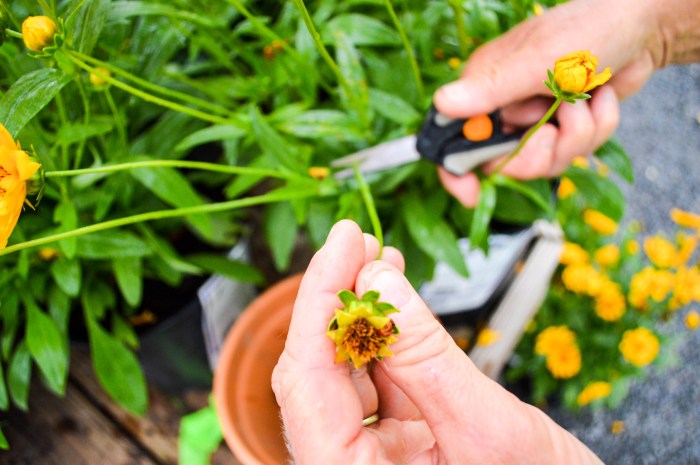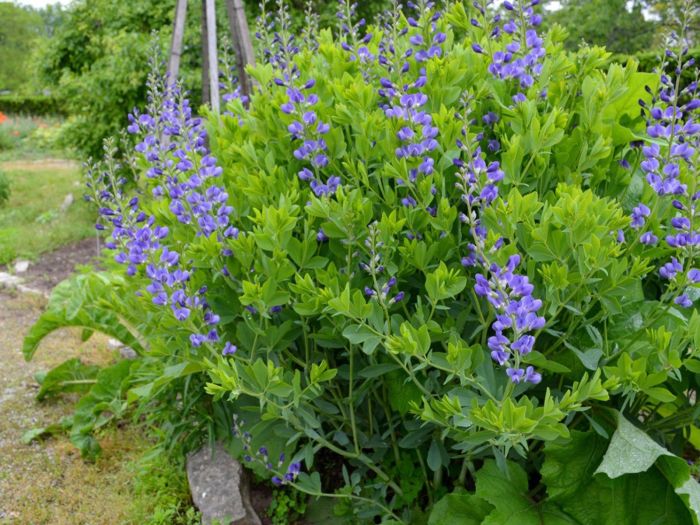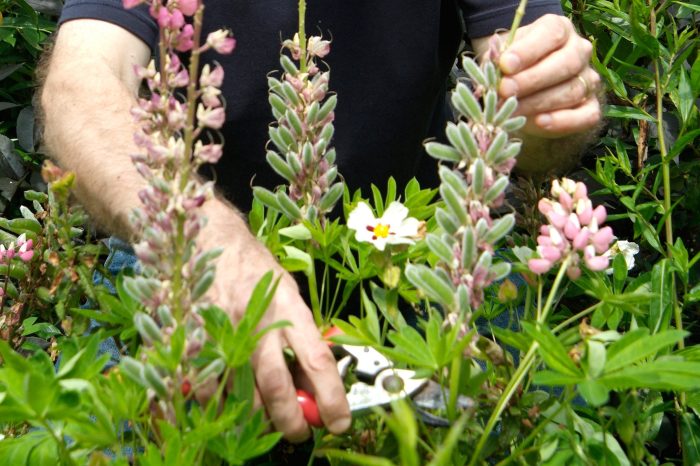Plants you should not deadhead might seem counterintuitive, especially when we’re accustomed to the benefits of deadheading for many flower species. But some plants thrive when allowed to keep their spent blooms, even if it means a lack of fresh flowers for our enjoyment.
This practice, known as deadheading, can actually harm these specific plants by disrupting their natural growth cycle or hindering seed production, which is essential for their propagation.
Understanding which plants to deadhead and which to leave alone is crucial for ensuring their health and longevity. This article delves into the reasons why certain plants should not be deadheaded, explores alternative methods for promoting flowering, and provides a visual guide to help you identify and care for these unique plants.
Understanding Deadheading

Deadheading, also known as pinching or trimming, is a common gardening practice that involves removing spent flowers or seed heads from plants. This practice is beneficial for various reasons, primarily promoting healthier growth and extending the flowering period.
Benefits of Deadheading
Deadheading encourages plants to focus their energy on producing new flowers instead of developing seeds. This results in a more prolonged and abundant bloom, enhancing the overall visual appeal of the garden.
- Increased Flower Production:Removing spent flowers signals to the plant that it needs to produce more blooms, leading to a greater number of flowers. This is especially beneficial for plants that naturally produce only a limited number of flowers.
- Extended Blooming Period:Deadheading prevents the plant from expending energy on seed production, extending the flowering season and allowing you to enjoy blooms for a longer period.
- Improved Plant Health:Removing spent flowers can prevent the spread of diseases and pests, contributing to the overall health and vitality of the plant. Deadheading also encourages bushier growth and can help prevent the plant from becoming leggy.
- Enhanced Appearance:Deadheading maintains a tidy and aesthetically pleasing appearance, eliminating wilted flowers and promoting a more vibrant and healthy look.
Plants that Benefit from Deadheading
Deadheading is a valuable practice for a wide range of plants, particularly those that produce flowers over an extended period.
- Annuals:Many annuals, such as zinnias, petunias, and marigolds, benefit greatly from deadheading. This practice encourages them to produce a continuous supply of flowers throughout the growing season.
- Perennials:Deadheading is also beneficial for perennials like roses, coneflowers, and salvia. Removing spent flowers helps promote healthier growth and extends the flowering period.
- Shrubs:Some shrubs, such as hydrangeas and rhododendrons, can benefit from deadheading. It can help encourage new flower buds and improve the overall appearance of the plant.
Alternative Methods for Promoting Bloom

While deadheading is a common practice for many flowering plants, certain species benefit from a different approach. Instead of removing spent blooms, alternative techniques can be employed to encourage continuous flowering. These methods often focus on providing the plant with optimal conditions for growth and bloom production.
Pruning
Pruning can be a powerful tool for stimulating flowering in plants that do not require deadheading. By removing specific types of growth, you can direct the plant’s energy towards producing more blooms.
- Pinching Back: This technique involves removing the tips of stems, encouraging bushier growth and more flower buds. Pinching back is particularly effective for plants like marigolds and zinnias, which tend to become leggy without regular pruning.
- Thinning: Thinning involves removing weak or overcrowded stems, allowing the remaining stems to receive more sunlight and nutrients. This practice can be beneficial for plants like roses and hydrangeas, promoting larger and more vibrant blooms.
Fertilizing
Adequate fertilization is essential for promoting healthy growth and abundant flowering. Plants require a balanced supply of nutrients to thrive, and fertilization helps ensure they have the resources they need to produce blooms.
- Choosing the Right Fertilizer: Different plant species have different nutritional requirements. Select a fertilizer specifically formulated for the type of plant you are growing. For example, flowering plants typically benefit from fertilizers with a higher phosphorus content.
- Timing of Application: Fertilize your plants during their active growth period, typically in the spring and summer months. Avoid over-fertilizing, as this can lead to excessive foliage growth at the expense of flowering.
Sunlight, Plants you should not deadhead
Sunlight is crucial for photosynthesis, the process by which plants convert light energy into food. Adequate sunlight is essential for promoting healthy growth and abundant flowering.
While many plants benefit from deadheading, some thrive on their seed production. These are the ones that will reward you with more blooms if you leave the spent flowers alone. If you’re looking to create a more natural, wildflower-filled backyard , consider letting these plants go to seed and enjoy the natural beauty they offer.
This can also help attract beneficial insects and pollinators to your garden.
- Light Requirements: Different plant species have different light requirements. Some plants thrive in full sun, while others prefer partial shade. Choose a location that provides the appropriate amount of sunlight for your chosen plant.
- Optimizing Light Exposure: If your plant is not receiving enough sunlight, consider relocating it to a brighter spot. You can also use reflective materials to increase the amount of sunlight reaching the plant.
Common Mistakes and Solutions: Plants You Should Not Deadhead

Deadheading, while a beneficial practice for many plants, can sometimes lead to unintended consequences if not done correctly. Understanding common mistakes and their solutions is crucial for promoting healthy plant growth and maximizing blooms.
Incorrect Deadheading Technique
The method of deadheading can significantly impact the plant’s health and future blooms. Incorrect techniques can lead to damage to the plant, reducing its ability to produce flowers.
- Cutting too close to the stem:Removing the flower head too close to the stem can damage the plant’s growth point, hindering future flower production.
- Leaving behind spent flower stalks:Leaving the spent flower stalks on the plant can encourage fungal diseases and pests, negatively affecting overall plant health.
- Deadheading at the wrong time:Deadheading too early can prevent the plant from forming seeds, which are essential for some plants to produce more blooms the following year. Deadheading too late can lead to the formation of seed pods, which can drain the plant’s energy.
Solution:
- Cut above a leaf node:Always cut the flower stalk above a leaf node, leaving a small portion of the stalk intact. This ensures that the plant can continue to produce new flowers.
- Remove the entire flower stalk:For plants that do not form seed pods, removing the entire flower stalk after blooming is the best practice. This prevents the plant from wasting energy on producing seeds and encourages new blooms.
- Deadhead at the appropriate stage:The ideal time for deadheading is when the flowers have faded but before the seed pods form. This ensures that the plant has enough time to produce new blooms.
Over-Deadheading
Deadheading is a beneficial practice for promoting more blooms, but excessive deadheading can weaken the plant and hinder its growth.
- Removing too many flower heads:Over-deadheading can deplete the plant’s energy reserves, leading to stunted growth and fewer flowers.
- Deadheading before the plant has a chance to set seed:Some plants, such as biennials and perennials, need to set seed to produce new blooms the following year. Over-deadheading can prevent this process, resulting in fewer flowers in subsequent seasons.
Solution:
- Allow some flowers to set seed:For plants that benefit from seed production, leave a few flower heads intact to allow them to form seeds. This will ensure that the plant has enough energy reserves for future growth and blooms.
- Deadhead selectively:Instead of removing every spent flower head, focus on deadheading those that are fading or have already set seed. This allows the plant to conserve energy and produce more blooms.
Ignoring Plant-Specific Deadheading Needs
Different plants have different deadheading requirements. Some plants benefit from deadheading, while others do not.
- Deadheading plants that do not require it:Deadheading plants that do not benefit from this practice can actually hinder their growth and reduce the number of blooms.
Solution:
- Research plant-specific needs:Before deadheading any plant, research its specific requirements. Some plants, such as roses, benefit from deadheading, while others, such as poppies, do not.
Visual Guide

To better understand the concept of deadheading and its effects on different plants, it’s helpful to visualize the process. This section provides a visual guide, featuring various plants and their respective deadheading requirements. By examining these examples, you can gain a clearer understanding of which plants benefit from deadheading and which plants are better left untouched.
Visual Representation of Deadheading Effects
The following table illustrates the effects of deadheading on different plants. It showcases the plant’s name, an image of the plant, its deadheading requirements, and alternative methods for promoting bloom.
| Plant Name | Image | Deadheading Requirements | Alternative Methods for Promoting Bloom |
|---|---|---|---|
| Rose | [Image of a rose bush with multiple blooms in various stages of development, showcasing the impact of deadheading on flower production. The image should highlight the difference between a deadheaded rose bush with abundant blooms and a non-deadheaded rose bush with fewer blooms.] | Deadheading encourages continuous flowering by removing spent blooms and preventing seed formation. | Regular fertilization, proper watering, and providing adequate sunlight can enhance rose bloom production. |
| Lavender | [Image of a lavender plant with a dense cluster of purple flowers. The image should showcase the plant’s typical appearance and the potential for seed production after flowering. The caption should highlight how deadheading can impact the plant’s overall appearance and flowering potential.] | Deadheading can promote a more compact and bushy growth habit, but it can also reduce the production of lavender oil. | Regular pruning and fertilizing can encourage bushier growth and increase flowering. |
| Poppy | [Image of a poppy plant with a single, vibrant red flower. The image should showcase the plant’s delicate beauty and the importance of seed production for its propagation. The caption should highlight how deadheading can hinder the plant’s natural life cycle and impact its ability to produce seeds.] | Deadheading is not recommended for poppies, as it can hinder seed production and reduce the overall number of flowers in subsequent seasons. | Allowing the poppy plant to produce seeds naturally ensures the propagation of the species and the continuation of its life cycle. |
| Cosmos | [Image of a cosmos plant with multiple flowers in various colors, showcasing the plant’s vibrant and cheerful appearance. The image should highlight the potential for deadheading to encourage more blooms and prolong the flowering period.] | Deadheading can encourage more blooms and prolong the flowering period of cosmos plants. | Providing adequate sunlight, regular watering, and fertilization can also enhance the plant’s flowering potential. |
Closure

Ultimately, understanding the specific needs of your plants is key to their flourishing. While deadheading is a valuable practice for many, some plants prefer a different approach. By learning to recognize these unique plants and their requirements, you can ensure a thriving garden that celebrates the diverse beauty of the natural world.